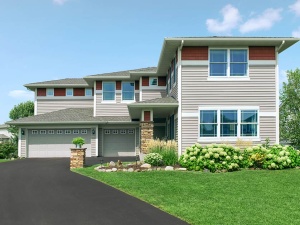When it comes to enhancing the appearance and functionality of your home, the choice of windows plays a crucial role. This begs the question: should all your windows match? The answer is nuanced and depends on several factors including design authenticity, your home’s relationship with its environment, and, of course, personal preference. Let’s learn more about it in this post.
The Front Doesn’t Have To Determine All the Other Sides
It’s common practice to aim for a certain aesthetic appeal from the street view. Many might choose traditional, symmetrical windows to present a warm, welcoming face to their neighborhood. However, this doesn’t mean that the rest of the house needs to follow suit rigidly. Variations in size, style and functionality of windows on less visible sides of the house can offer unique advantages while maintaining a cohesive design. By ensuring that basic aspects such as type, grille patterns and trim are consistent, a home can feature a variety of window styles without compromising its architectural integrity.
Planning Window Placement: Leveraging Natural Light and Views
Strategic window placement is key to maximizing natural light, embracing stunning views and ensuring comfort within the home. Exposures on the west- and east-facing walls require special consideration due to the low angle of sunlight, which might necessitate the use of shades or positioning the sill higher to reduce glare in rooms used for watching television or working on computers. On the other hand, south-facing walls, especially in warmer climates, might benefit from shading devices to minimize heat gain during summer.
Designing With Comfort in Mind
Comfort isn’t just about managing light and views; it also encompasses thermal comfort. Modern window materials offer superior insulation. However, large panes can still impact a room’s temperature. In colder climates, large windows might need to be positioned to benefit from direct heat sources. However, this is less of a concern for homeowners in warmer climates who can instead focus on minimizing heat gain through strategic placement and the use of shading over south-facing windows.
Do’s and Don’ts for Mixing Window Styles
When renovating or extending a home, it’s possible to mix window styles without losing a sense of harmony. The key lies in maintaining consistency in trim, grille patterns and muntin style across different types of windows. This approach allows homeowners to integrate modern windows that offer better functionality, without clashing with the existing architectural style.
Understanding the Role of Windows in Different Rooms
Each room within a home serves a unique purpose, and this should influence window choice. For instance, living rooms can accommodate larger windows to capitalize on views and light, while bathrooms require privacy, making frosted or high-placed windows a better choice. Similarly, bedroom windows need to facilitate adequate ventilation and egress in case of emergency, dictating size and operability.
Now that you know that you can mix and match or go with your own style in your window replacement, you can rely on us at Renewal by Andersen of Sacramento to have your new windows installed. Choose from our extensive selection of high-quality replacement windows, with customization options for exterior colors, interior finishes, hardware and grilles. Call us at (916) 779-5800, or fill out this contact form to schedule a consultation.







